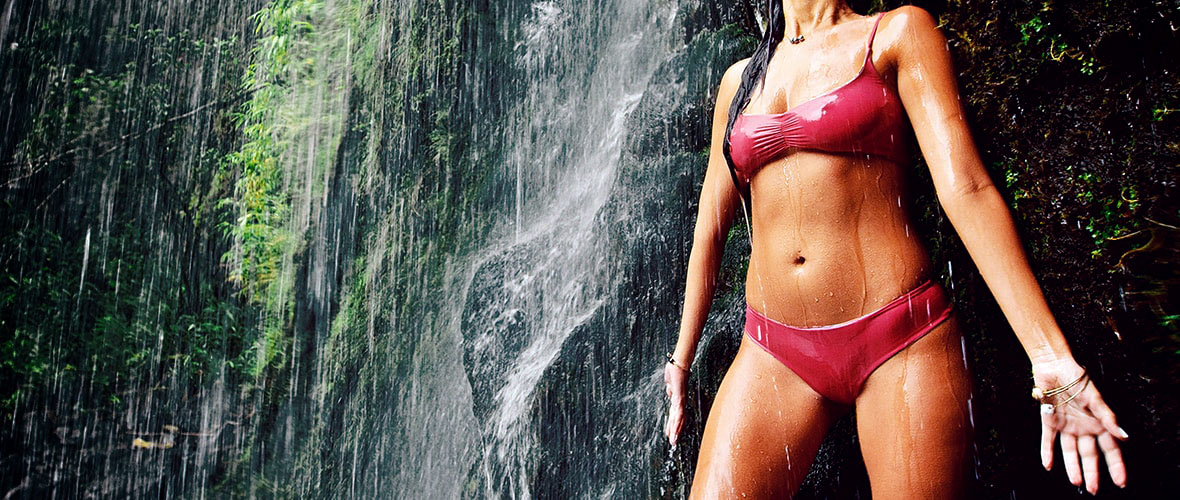In the high-stakes world of extreme sports, ice climbing is one of the most exhilarating — and terror-inducing — outdoor adventures on earth.
A Cold Reality
It is not for the fainthearted; in fact, of the 5.7 million Americans who participate in the many forms of climbing each year, only five percent venture anywhere near the perilous conditions associated with climbing around on ice. But for those few thrill seekers who are undaunted by the risks, ice climbing is the only way to go.
My own objectives in the extreme ice-climbing game seemed simple enough: to add a little adventure to an otherwise dreary winter and stay in one piece long enough to discover what made the sport so appealing to a balls-to-the-wall minority. The problem, however, was that I’d never been the bravest of souls when it came to climbing; I’d been harboring a fear of heights most of my life.
How significant was this phobia? I’d frozen up something awful during an indoor climbing class at the University of Calgary some years back, and ended up being the only one in the group who didn’t make it to the top of the man-made wall. At the time, I blamed my reluctance on the instructor, who kept turning around to talk to some of the ladies in their skin-tight climbing outfits and didn’t seem to be paying much attention to me as I hung on for dear life, two stories above the floor. But in my heart of hearts I knew that the shortcoming had been my own, and I was hoping to make things right on my ice adventure.
So, early one cold morning I left my hotel room in Canmore, Alberta — somewhat uncertain but determined to overcome my fear and accomplish my initial goals — and began the three-hour drive up the Ice-fields Parkway to the Sunwapta ranger station in Jasper National Park. The air was crisp and clear, and the mountains, bathed in the golden light of dawn, were visible for miles in all directions.
The drive was going great … until I noticed the numerous near-vertical streams of ice cascading from the tops of the peaks. Suddenly the harsh reality of what I was about to do sent a spike of terror up my spine. These 3,000-foot-high frozen waterfalls are part of the reason that the Canadian Rockies are known as the ice-climbing mecca of the world.
At the Sunwapta ranger station, Joe McKay — mountain guide, mountaineer, and ice-climbing fool — met me at the door, and after a few pleasantries led me down a flight of stairs to pick out the gear we would need for the climb.
The best way to describe ice-climbing equipment is to say that it is sharp — razor sharp. And one of the sharpest tools in an ice climber’s arsenal is the ice ax. Resembling a weapon out of a kung fu movie, these implements are made of steel, fiber-glass, aluminum alloy, or, more recently, carbon fiber. They range in length from 16 to 28 inches, have various picks depending on their particular use, and an anvil at the head opposite the pick.
The runner-up for “most likely piece of equipment on which a climber can become impaled” has got to be the crampon. Modern ice climbers rely on two different types: the mono-point adjustable crampon (for waterfall ice) and the flexible 12-point (for alpine climbing). Climbers also use tubular ice screws (again, really sharp), which are designed to allow the ice to “drain” through the center, and water-repellent ropes that don’t freeze easily in the subzero temperatures associated with ice climbing. Other equipment includes plastic mountaineering boots, waterproof climbing suits, pitons (wedges or pegs that are driven into the ice for support), slings, and helmets for protection against falling rocks or ice.
It was mid afternoon by the time we completed our drive back down the also extreme lce Fields Parkway and arrived at a trail that led to the Weeping Wall, a giant curtain of ice. The Wall is one of the most famous ice routes in Canada, owing to the fact that even its lower pitches reach points higher than 500 feet. We grabbed the gear out of my Jeep and began the five-minute hump to the base. Without crampons on our feet, the going was slippery and slow, but since we didn’t have much of a hike, McKay had decided against wearing the spiked irons.
When we reached the Weeping Wall, it was doing just that: weeping. Streams of water poured down from overhead. The south-facing curtain of ice had been hit hard by the direct sunlight since noon, and the surface was getting soft. McKay felt that it wouldn’t be long, maybe just a week or so, before the Wall would become altogether unclimbable. If I had showed up any later in the season, I might have missed the window of opportunity on ice climbing in that area.
After suiting up, it was finally time for a lesson, and McKay began by describing — and demonstrating — the correct method for using the deadly ice ax. “Bring it back over your shoulder like this, but not too far,” he cautioned. “As you swing it forward, let your wrist release, and the ax will be placed properly into the ice without your smashing your hands. Remember, the releasing of the wrist is the real important part of the swing — that’s where you get most of the power.”
Within 15 minutes we had covered the use of the rest of the equipment, the belaying process (securing the ropes at various intervals) that would later get us down the Wall, and a few more techniques used for successful ice climbing. Then McKay was off, attacking the first pitch of the Weeping Wall and displaying the smooth movements and precise tool placements gained from more than 18 years’ climbing experience. He quickly reached a small ledge, anchored himself to it with ice screws, then signaled for me to begin my ascent.
Tied by a rope to an experienced climber, I was nonetheless infused with terror. My life was passing before my eyes — ever heard that one before? — and I hadn’t even begun the climb. There was no choice, though; I simply had to climb. I couldn’t come off looking like a pussy in front of this guy who risked his life on the mountains almost every day. So I sucked it up, moved to the base of the Weeping Wall, drew back the ice ax in my right hand, and swung like there was no tomorrow. At the time, I didn’t think there would be.
Unfortunately, I ended up looking like a pussy, anyway. The ax didn’t penetrate far enough to support the weight of a gerbil, much less my 175 pounds – an inauspicious beginning for me extreme ice foray, as you can tell. But at least I didn’t rap my knuckles on the ice, I thought. My next swing was much harder, but once again the technique sucked, and though the ax struck deeper into the ice, this time my knuckles did in fad smash into the unforgiving surface.
During the ascent, my crampons and ice axes periodically wrenched loose from the ice, leaving the rope and McKay’s strength as all that kept me from a bad case of broken bones — or death. “Remember to keep your heels flat when you kick the toe of the crampon into the ice, and make sure at least one of the axes is secure before trying to move on,” McKay yelled from above when he grew tired of half-dragging my sorry ass up the Weeping Wall. After what seemed like an unbearable hour of scratching and crawling, I finally reached McKay’s location.
When at last I was anchored into the wall with three ice screws, I eased into my surroundings. I became comfortable surveying the land from this new position. It was then that it hit me: The concentration I was forced to use while climbing the Weeping Wall had erased the fear I had felt prior to my attempt. I was a bigger person than the fellow who, years earlier, was the failure of his climbing class. And then, just as my excitement peaked, McKay gave me a short lesson in belaying before lowering me back down the ice. He figured we had gone high enough for my first day.
The origins of ice climbing can be traced back more than 2,000 years. Some of the first people to grapple successfully with ice were not climbers at all but sheep herders tending their flocks high in the Atlas Mountains of North Africa. To accomplish this arduous task, they fashioned spiked three-point devices to the bottoms of their boots (the first make-shift crampons), using their staffs for additional support and balance.
“I hung on for dear life. At long last I could tell people I was at the end of my rope … and mean It.”
By the 1700s, shepherds living in Europe’s Alps adapted a similar crampon and a modified staff, or alpenstock, pre-cursor to the modern ice ax. The extreme ice aipenstock was a long stick — in some cases taller than a man — with an iron tip at one end for penetrating the ice. By the latter part of the eighteenth century, English mountaineers had arrived on the scene and begun hiring the shepherds as guides into the icy, snow-covered mountain region. Almost overnight, it seemed, the peaks of the Alps became immensely popular with the adventurous Brits, and climbing for recreation was born.
As decades passed, ice climbing became a unique outdoor experience in and of itself, and over the past 15 to 20 years an ever-increasing number of adventurers have taken up the sport worldwide. Today, it’s estimated that there are more than 285,000 ice climbers in the United States alone. The sport now encompasses a whole range of terrain, including radically difficult mixed climbs (on both rock and ice), waterfalls, alpine ice routes, hanging icicles, and man-made ice walls.
It seems that anywhere there’s even the slightest trace of ice, there is a climber with large enough cojones to risk life and limb to reach the top of the route and claim the prize. Competitions both on man-made walls (think X-Games) and in ice parks, as at the Ice Craft exhibition held every year in Colorado’s Ouray Ice Park, offer everything from mixed routes to vertical walls, providing climbers with the opportunity to match their skills and wits against one another.
On the next day of my ice-climbing adventure, McKay and I arrived around noon at Lake Louise in Jasper National Park. The sky was blanketed with a thin layer of clouds, and the air was quite a bit cooler than on the previous day. After making the 45-minute hike to Louise Falls at the end of the lake, McKay and I attached our crampons and marched up a snow-covered embankment to the base of the light blue wall of ice.
Once again we went through the routine of unpacking our gear and suiting up; then McKay climbed the first pitch in the same proficient manner he had demonstrated at the Weeping Wall, taking the time to ensure each tool was positioned perfectly before moving onward. “If I’m not sure about the placement of my axes or crampons, I’ll keep banging away until. I am,” he shouted down to me as he made the ascent. “That way I will not lose confidence in my next move. You don’t ever want to let the ice beat you.”
On this day we climbed higher, up several pitches, and once again my technique lacked polish. While struggling up the first pitch, my axes and crampons suddenly let go of the ice at the same time, and McKay had to pull hard on the rope to keep me from plummeting to the bottom of the falls.
When we finally made it to the highest point that McKay was willing to take a rookie like me, he anchored me into the ice, then climbed around like a monkey on a thin pillar of hanging icicles, while describing how he was placing his tools and what kinds of things to look for while doing that type of climbing.
When it was at last time to descend, McKay decided that the best way to get me down was to belay me over a cliff located off to one side of Louise Falls. As he tied two ropes to my harness, he mentioned — rather nonchalantly, given the situation, I thought — that it was better to use a pair of ropes, just in case one got severed on the cliff’s sharp rocks. And even though he assured me that the two ropes would hold, all I could think as I worked my way slowly backward toward the edge — and certain doom — was, If the rocks are sharp enough to cut one rope, then what, exactly, Is stopping them from cutting through both?
It was then, as my heart pounded in my chest and my blood was fired with adrenaline that coursed through my veins faster than an avalanche sweeps down the side of a mountain, that McKay tried to set my mind at ease. “Don’t worry, I won’t let you fall,” he said with a grin. “It would be a really long walk for me back to Banff.” He instructed me to place my trust in the equipment, and to lean back when he lowered me over the edge so that I wouldn’t rap my knees — and some other more vital parts of my body — on the rocks.
This was it — time to go. I continued walking backward until I could see no ground beneath me, and then, as instructed, leaned back completely and hung on for dear life while trying in vain not to look down. At long last I could tell people that I was at the end of my rope … and mean it. Being suspended over the sharp rocks 100 feet below was almost more than I could bear, but after smashing my knees on the side of the cliff a few times, I decided it probably would be better if I stopped moving around so much and tried to relax. One way or another, this ride would be over soon enough.
Being lowered over the cliff was one of the most horrifying experiences of the trip. But by the time McKay and I had reached bottom and packed up, my heart had stopped pounding long enough for me to reflect on the climb itself and I felt a certain pride. Not because I had conquered the ice — I wasn’t fool enough to think that was the case — but because I had overcome, if only for a short while, the fears that had haunted me for so long.
If we have not convinced you that Extreme Ice should be a sport much more preferably experienced on a screen fed by some streaming service, these crazy people now have entire web sites devoted to gear, locations, and even training. … Who knows? Maybe these will bring you to your senses. We’d rather try to reinvigorate the cattle drive than do something where freezing is rather the point.

























